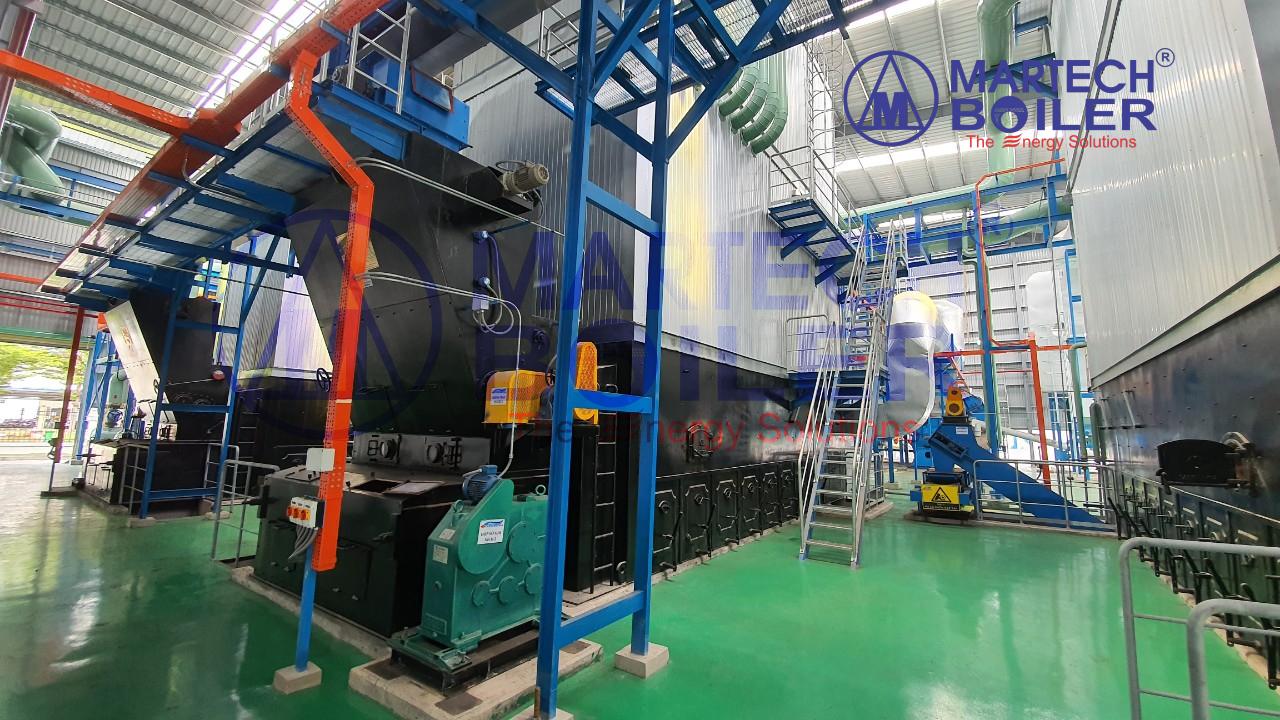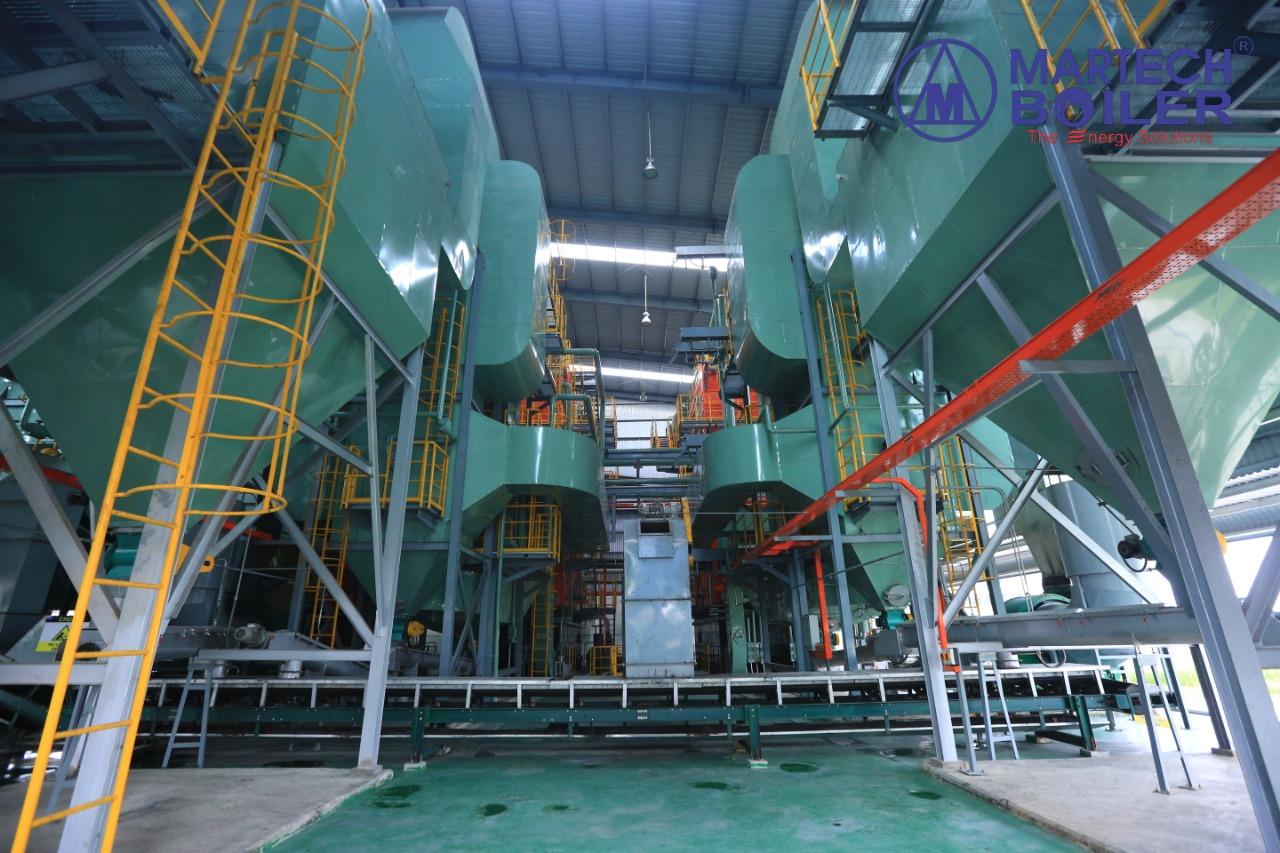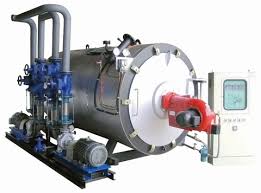
أبريل . 19, 2024 16:26 الرجوع للقائمة
WHAT IS THERMAL OIL HEATER(BOILER)?
THE PRINCIPLE OF THERMAL OIL HEATER
WHAT IS THERMAL OIL HEATER(BOILER)?
Thermal Oil Heater uses chain-type combustion chamber to burn fuel, the energy generated from fuel combustion will heat the heat transfer oil, the after-heat oil temperature can be up to 400°C. The heated oil will be sent to the equipment that uses heat in industrial production. However, in industrial production, the thermal oil boiler is only used for indirect heat exchange systems, meaning that the oil will pass through heat exchangers at the heaters and then returned to the oil heater to reheat, so that the oil circulates in a closed cycle. The industrial oil heater can reach capacities of up to 18 GCal / hour.

Thermal Oil Heater
THE PRINCIPLES OF OPERATION
1. Struture of the System
A chain grate thermal oil boiler system includes the following main equipment:
- Feeding system;
- Combustion chamber;
- Oil heater body;
- Air pre-heater and feeding system;
- Exhaust treatment system;
- The system of collecting ash
- Circulating oil pump;
- Oil tank system and expansion oil tank.

Diagram of the structure of main equipment in the thermal oil heater system
a. Fuel supply system to the boiler:
The feeding system includes equipment such as excavators, fuel hoppers, buckets, conveyors, screw conveyors, etc., which are controlled dynamically, quantitatively and automatically to fuel the oil heater. In addition, the feeding system is also equipped with a weight balance to determine the amount of fuel consumed for the thermal oil heater.
b. Chain-grate Combustion Chamber:
Air Box - Chaingrate system
The chain-grate will have a front feed hopper to store fuel, the fuel in the hopper will be evenly spread across the recording surface, the chain-grate will have two front and rear axles to keep the chain-grate in motion. During operation, the chain-grate will be pulled by a gearbox located on the front axle, when chain's moving, the fuel will gradually be fed into the combustion chamber and burned in the combustion chamber area, after exhaustion there will be ash, slag ash will be brought to the rear of the furnace and dropped into the ash pit at the end of the combustion chamber. The energy generated in the combustion chamber will lead to the top of the oil heater to heat the oil.
Fuel to burn on the burner requires air, the air will be fed from behind the combustion chamber and go to the bottom of the burner, the design has air slots so that the air can go from the bottom up and next contact with fuel and to burn fuel.
c. Oil Heater Body
Oil Heater Body
The oil heater body is placed above the combustion chamber, made up of heat exchanger pipes, oil will go in the pipe, hot smoke with high temperature generated from the combustion chamber will pass through these heat exchanger tube beams, the oil will receive heat and be heated gradually up to the required temperature. The heat exchanger tube in the oil furnace body is divided into two parts, the radiation tube and the convection heat exchanger tube. The hot smoke from the combustion chamber will have a very high temperature will enter the radiant heat exchanger tube area first (because when the smoke has high temperature, there will be a majority of radiant heat exchange coefficient), after leaving the tube area. Exchanger radiant heat, the smoke temperature will decrease and enter the convection heat exchanger tube area (now the smoke temperature has been much reduced so the convection heat exchange coefficient will account for the majority), the hot smoke after Heat exchanger to heat the oil will gradually reduce the temperature and go out.
For the oil heater body, when designing and operating it is necessary to ensure the oil velocity in the pipe, this is an extremely important parameter determining the life of the heat transfer oil and the oil furnace body. For each type of heat transfer oil, there is a requirement for the maximum allowable film temperature, which means that the oil temperature at the ductwork will not exceed this temperature, resulting in the oil stroke not being too low. Slow down and the oil temperature at the tube membrane will exceed the allowable level, causing oil damage, if it is severe, the oil will overheat and generate carbon deposits on the wall of the tube, which will cause blockage, leading to overheating of the pipe. Heat, pipe tank and soya sauce entering the combustion chamber, oil that catches fire will burn and is extremely difficult to extinguish, so it will be extremely dangerous. However, if the design of the oil speed is too high, it will increase the resistance, leading to the need to choose a pump with a higher pump head and higher pump capacity, leading to an increase in investment costs as well as electricity when operating. As such, it is necessary to ensure the appropriate design of the oil velocity in the convection and radiation pipes to ensure operation and save costs.
d. Air preheater and feeding system.
Air-Preheater
The air supply system is a critical system because no fuel burns without oxygen. The outdoor air is heated and fed into the combustion chamber to provide oxygen for combustion. A typical chain air supply system for chain grate consists of a feed fan and an air preheater. The fan takes the outdoor air into the air dryer, the air dryer is located behind the rear of the oil furnace, is a heat exchange device between the exhaust fumes after leaving the oil furnace and the air entering the combustion chamber. , the purpose of this air preheater is to take advantage of the excess energy in the smoke to transfer to the feed wind to make combustion easier, increasing the efficiency of the system and reducing the amount of fuel fed. combustion chamber. The supply air after leaving the air dryer is about 100 oC to 150 oC, this supply air temperature should not be designed too high because it can reduce the life of the combustion chamber and chaingrate.
e. Exhaust treatment system
Thermal Oil Heater Chimney
The exhaust gas treatment system is an important system, with the function of treating exhaust fumes meeting strict environmental standards before being discharged into the environment. Depending on the type of fuel, different treatment methods can be applied. For chain grate thermal oil heater, there are often options for treating exhaust gases such as bag filter, electrostatic dust filter or ventury in combination with dry filter tower and wet filter tower. The selection of suitable treatment methods depends on environmental standards, customer needs and the area of the premises so that a suitable treatment method can be selected.
A typical treatment system for a thermal oil boiler includes the following equipment:
• Silo: Using centrifugal principle to filter large dust particles.
• Bag filter, electrostatic or ventury dust filter combining dry filter tower and wet filter tower: has the function of collecting fine dust particles, with small size.
f.Air & Emission fan system
The induced fan has the function of sucking smoke from the oil heater through the exhaust gas treatment system and blowing out the chimney, the exhaust fan also has an important function of maintaining the pressure in the combustion chamber always negative, so that the combustion chamber don''t leak fire or smoke out of the combustion chamber, ensuring safety when operating.
Chimney: exhaust fumes after being treated to meet environmental standards will be exhausted by fans to the chimney, but the exhaust fumes temperature at the chimney are still quite high, about 100 ° C, so it is necessary to have a chimney to raise and discharge to environment, ensuring hot smoke is emitted out will have space to lower the temperature and ensure the ambient temperature is not too high.
غلاية زيت حرارية تعمل بالغاز
g. Ash treatment system
Any fuel after burning will remain ash, most will be discharged at the end of the combustion chamber, into a water tank because it is very hot so water is needed to cool, the ash in the rear of the furnace after cooling will be pulled out by a dragging chain. Outside the back of the Boiler , a quantity of ash will be caught up in smoke and collected in the back exhaust gas treatment systems. The design of an ash system depends on the amount of ash to be collected and the site location to be designed accordingly. With small systems, the amount of ash is low, so it is possible to use a bag or a truck to collect, but with large systems, the amount of ash is too much, the collection by bags or excavators will no longer be suitable, at this time an automatic collection system to the warehouse will be more suitable and economical.
h. Circulating oil pump system.
Cụm bơm dầu
The circulating oil pump transports the oil from the oil heater to the factory production line and pull it back to the pump and then refills it back into the oil heater to continue heating, forming a closed cycle. The calculation of the circulating oil pump is extremely important, depending on the type of heat transfer oil, the working temperature, the oil flow rate and the resistance of the system. Choosing too small oil pump will not ensure the oil flow for the system, insufficient oil through the boiler causes oil burn and damage, insufficient oil flow will cause heat-using equipment to operate incorrectly. . Choosing an oil pump with too large flow will increase the system resistance, increase the motor capacity, causing wastage of electricity when operating (because oil pump capacity often accounts for a large proportion in the operating electricity system). Thus, the circulating oil pump needs to be suitable to ensure the system operates and save operating costs at the most appropriate level.
i. Oil tank and expansion tank system

Oil Tank & Oil Expansion Tank
With the oil heater system, the expansion oil tank will be placed at the top of the system to ensure that the oil in the system is always filled up. When the heater is not started, the heat transfer oil is filled into the oil heater system, piping and heat-using equipment, then the oil is cooled down and the oil level on the expansion oil tank will be lowest. When the heated combustion chamber heats the system oil up to the working point, the oil expands and is sent to an expansion tank and stored there. The volume of the expansion oil tank must be designed so that this amount of expansion oil can be stored.
The oil tank will usually be placed underground, usually when operating the oil tank that contains very little or no oil because the amount of oil for the system to work is stored in the expansion oil tank. The main function of the oil tank is to store oil when the oil furnace system needs to be repaired, the oil needs to be collected to the oil tank for reuse. The amount of heat transfer oil in the system is usually very large, so it is necessary to design the oil tank volume to ensure that when there is a need to repair the equipment assemblies in the system, the oil can be withdrawn.
2. The principles of the Thermal Oil Heater system.

PFD Diagram of Thermal Oil Heater
Fuel is fed into the fuel storage hopper in front of the combustion chamber, the chain recorder will put fuel into the combustion chamber, and the feed fan will run to supply air into the combustion chamber to burn fuel. The combustible fuel produces hot smoke at high temperature and is carried to the oil furnace. In the oil furnace body are heat exchanger pipes, oil will go inside the tube, hot smoke from the combustion chamber outside the tube will heat the oil inside. After the heating process, the hot smoke will gradually lose its heat energy and be sucked out by the fan to the rear of the oven into the air heater. The hot smoke enters the air heater to heat the intake air into the combustion chamber, the feed air is heated up when fed into the combustion chamber, making the combustion of fuel easy and increasing system efficiency. The hot smoke after coming out of the air dryer will enter the exhaust gas treatment system to meet environmental standards and be blown out of the chimney by the exhaust fan.
As for the thermal oil, the cold oil from the equipment using heat is drawn back by the circulating oil pump and brought into the body of the heated oil furnace to heat up, fed back to the equipment using heat. In the oil pipeline, there will be an automatic gas separation line, the gas separation line has the function of separating the gas in the system, especially when the oil is not in the system and the oil supply will have to run for a while to separate the gas. . There is also a filling line in the system, the task of this line is to supply oil into the system, and this thick filling line will ensure that the oil in the system is always filled up and running stably.
The ash collection system depends on the type of fuel and the amount of ash to be collected will have appropriate designs, the fuel after burning will produce ash, a large amount of ash with a large volume will be collected at the rear of the boiler. The light ash will be blown away by smoke out of the air dryer, exhaust gas treatment system and collected in these equipment.
ADVANTAGES AND THE DISADVANTAGE OF CHAIN GRATE THERMAL OIL HEATER.
1. Advantages:
Simple structure, easy operation, low maintenance cost, no consumption of chemicals.
• Working oil temperature can be up to 400 oC with low pressure, suitable for high temperature systems, the cost for low pressure equipment will be cheaper.
• Do not corrode the heat exchanger pipe in the oil furnace, the service life will be longer.
• Thermal oil boilers are widely used in industry and used to replace industrial boilers because thermal oil boilers can provide high temperatures, while the Industrial Steam Boiler need a very high pressure to heat up the steam reach that temperature by using the Heat Exchanger it cause higher price.

Pressure / temperature correlation graph of steam and oil
• Suitable for burning solid fuels with large size, large particle size up to 50mm, diverse fuels: coal bran, chopped firewood, rice husks, wood pellets, rice husks ....
Fuel
2. Disadvantages:
Oil boilers often operate at high temperatures, so the design and selection of equipment must ensure the safety of the operator and the system.
• When using heat transfer oil, it is required to take samples every 6 months to check whether the oil is still usable. If designed and operated properly, the heat transfer oil will have a long service life.
• The cost of heat transfer oil is quite high.
• It is more dangerous to operate a thermal oil boiler, so operators must be trained to meet the technical requirements of the operation.
Through this article we hope that you have been provided with an overview and have more understanding about the operating principle as well as the advantages of the thermal oil furnace system. In the next topic we will learn how the fluidized bed boiler system works.
-
Types of coal fired steam boiler: Efficient & Low Emissions
أخبارNov.17,2025
-
Types of Coal Fired Steam Boiler | Efficient & Reliable
أخبارNov.17,2025
-
Reliable Steam Boiler Supplier for Industrial Solutions
أخبارNov.17,2025
-
Coal Fired Hot Water Boiler | High Efficiency & Durable
أخبارNov.17,2025
-
Reliable Industrial Steam Boiler Manufacturers for Efficient Operations
أخبارNov.17,2025
-
Commercial Steam Boilers for Sale - Efficient, Gas & Oil
أخبارNov.17,2025
متعلق ب منتجات





























